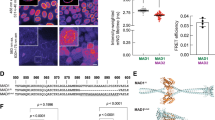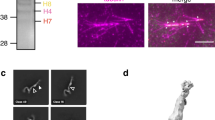Abstract
The spindle assembly checkpoint (SAC) guards against chromosomal mis-segregation and the emergence of aneuploidy. SAC in higher eukaryotes includes at least 10 proteins including MAD1-3, BUB1-3, and Msp1. A long-standing observation has been that rodent cells are more tolerant of microtubule toxins than primate cells indicating that SAC function is more relaxed in the former than the latter. Here, we report on an unexpected functional difference between the rodent and human MAD1 component of the respective SAC. Ectopic expression of human MAD1 in mouse and hamster cells corrected a relaxed SAC to a more stringent form. Our findings posit MAD1 as a species-specific determinant which influences the stringency of cellular response to microtubule depolymerization and spindle damage.
This is a preview of subscription content, access via your institution
Access options
Subscribe to this journal
Receive 50 print issues and online access
$259.00 per year
only $5.18 per issue
Buy this article
- Purchase on Springer Link
- Instant access to full article PDF
Prices may be subject to local taxes which are calculated during checkout








Similar content being viewed by others
References
Abrieu A, Kahana JA, Wood KW, Cleveland DW . (2000). Cell 102: 817–826.
Azran I, Schavinsky-Khrapunsky Y, Aboud M . (2004). Retrovirology 1: 20.
Babu JR, Jeganathan KB, Baker DJ, Wu X, Kang-Decker N, van Deursen JM . (2003). J Cell Biol 160: 341–353.
Basto R, Gomes R, Karess RE . (2000). Nat Cell Biol 2: 939–943.
Bharadwaj R, Yu H . (2004). Oncogene 23: 2016–2027.
Chen RH, Shevchenko A, Mann M, Murray AW . (1998). J Cell Biol 143: 283–295.
Chung E, Chen RH . (2002). Mol Biol Cell 13: 1501–1511.
Dai W, Wang Q, Liu T, Swamy M, Fang Y, Xie S et al. (2004). Cancer Res 15: 440–445.
De Antoni A, Pearson CG, Cimini D, Canman JC, Sala V, Nezi L et al. (2005). Curr Biol 15: 214–225.
Downes CS, Musk SR, Watson JV, Johnson RT . (1990). J Cell Biol 110: 1855–1859.
Draviam VM, Xie S, Sorger PK . (2004). Curr Opin Genet Dev 14: 120–125.
Duesberg P, Li R . (2003). Cell Cycle 2: 202–210.
Fang G . (2002). Mol Biol Cell 13: 755–766.
Gallardo MH, Bickham JW, Kausel G, Kohler N, Honeycutt RL . (2003). J Evol Biol 16: 163–169.
Grassmann R, Berchtold S, Radant I, Alt M, Fleckenstein B, Sodroski JG et al. (1992). J Virol 66: 4570–4575.
Grossman WJ, Kimata JT, Wong FH, Zutter M, Ley TJ, Ratner L . (1995). Proc Natl Acad Sci USA 92: 1057–1061.
Hahn WC, Weinberg RA . (2002). Nat Rev Cancer 2: 331–341.
Haines DC, Chattopadhyay S, Ward JM . (2001). Toxicol Pathol 29: 653–661.
Hardwick KG, Johnston RC, Smith DL, Murray AW . (2000). J Cell Biol 148: 871–882.
Hartwell L . (1992). Cell 71: 543–546.
Holliday R . (1996). Cancer Surv 28: 103–115.
Hoyt MA, Geiser JR . (1996). Annu Rev Genet 30: 7–33.
Iwanaga Y, Kasai T, Kibler K, Jeang KT . (2002). J Biol Chem 277: 31005–31013.
Jeang KT, Giam CZ, Majone F, Aboud M . (2004). J Biol Chem 279: 31991–31994.
Kasai T, Iwanaga Y, Iha H, Jeang KT . (2002). J Biol Chem 277: 5187–5193.
Kung AL, Sherwood SW, Schimke RT . (1990). Proc Natl Acad Sci USA 87: 9553–9557.
Lee MS, Spencer FA . (2004). Proc Natl Acad Sci USA 101: 10655–10660.
Lengauer C, Kinzler KW, Vogelstein B . (1997). Nature 386: 623–627.
Lengauer C, Wang Z . (2004). Nat Genet 36: 1144–1145.
Li H, Cuenin C, Murr R, Wang ZQ, Herceg Z . (2004). EMBO J 23: 4824–4834.
Ling V, Thompson LH . (1974). J Cell Physiol 83: 103–116.
Luo X, Tang Z, Rizo J, Yu H . (2002). Mol Cell 9: 59–71.
Luo X, Tang Z, Xia G, Wassmann K, Matsumoto T, Rizo J et al. (2004). Nat Struct Mol Biol 11: 338–345.
Matsumoto K, Shibata H, Fujisawa JI, Inoue H, Hakura A, Tsukahara T et al. (1997). J Virol 71: 4445–4451.
Matsuoka M . (2005). Retrovirology 2: 27.
Michel LS, Liberal V, Chatterjee A, Kirchwegger R, Pasche B, Gerald W et al. (2001). Nature 409: 355–359.
Midgley AR, Pierce B, Dixon FJ . (1959). Science 130: 40–41.
Murray AW . (1992). Nature 359: 599–604.
Musacchio A, Hardwick KG . (2002). Nat Rev Mol Cell Biol 3: 731–741.
Nasmyth K . (2005). Cell 120: 739–746.
Rangarajan A, Hong SJ, Gifford A, Weinberg RA . (2004). Cancer Cell 6: 171–183.
Rao CV, Yang YM, Swamy MV, Liu T, Fang Y, Mahmood R et al. (2005). Proc Natl Acad Sci USA 102: 4365–4370.
Rieder CL, Maiato H . (2004). Dev Cell 7: 637–651.
Rosin O, Koch C, Schmitt I, Semmes OJ, Jeang KT, Grassmann R . (1998). J Biol Chem 273: 6698–6703.
Rudner AD, Murray AW . (1996). Curr Opin Cell Biol 8: 773–780.
Schimke RT, Kung AL, Rush DF, Sherwood SW . (1991). Cold Spring Harb Symp Quant Biol 56: 417–425.
Shah JV, Botvinick E, Bonday Z, Furnari F, Berns M, Cleveland DW . (2004). Curr Biol 14: 942–952.
Shah JV, Cleveland DW . (2000). Cell 103: 997–1000.
Sironi L, Melixetian M, Faretta M, Prosperini E, Helin K, Musacchio A . (2001). EMBO J 20: 6371–6382.
Steinmann KE, Belinsky GS, Lee D, Schlegel R . (1991). Proc Natl Acad Sci USA 88: 6843–6847.
Takatsuki K . (2005). Retrovirology 2: 16.
Tanaka A, Takahashi C, Yamaoka S, Nosaka T, Maki M, Hatanaka M . (1990). Proc Natl Acad Sci USA 87: 1071–1075.
Vogel C, Kienitz A, Muller R, Bastians H . (2005). J Biol Chem 280: 4025–4028.
Wassmann K, Benezra R . (1998). Proc Natl Acad Sci USA 95: 11193–11198.
Wassmann K, Liberal V, Benezra R . (2003). EMBO J 22: 797–806.
Weiss E, Winey M . (1996). J Cell Biol 132: 111–123.
Wright WE, Shay JW . (2000). Nat Med 6: 849–851.
Yamaoka S, Inoue H, Sakurai M, Sugiyama T, Hazama M, Yamada T et al. (1996). EMBO J 15: 873–887.
Yu H . (2002). Curr Opin Cell Biol 14: 706–714.
Yunis JJ, Prakash O . (1982). Science 215: 1525–1530.
Acknowledgements
We thank A Dayton, J Ward, and members of the Jeang Laboratory for readings of manuscript; the NIAID core facility for MS-peptide sequencing; A Elmo for preparation of manuscript; and Y Li for technical assistance. This research was supported by the intramural research program of the NIAID, NIH.
Author information
Authors and Affiliations
Corresponding author
Rights and permissions
About this article
Cite this article
Haller, K., Kibler, K., Kasai, T. et al. The N-terminus of rodent and human MAD1 confers species-specific stringency to spindle assembly checkpoint. Oncogene 25, 2137–2147 (2006). https://doi.org/10.1038/sj.onc.1209259
Received:
Revised:
Accepted:
Published:
Issue Date:
DOI: https://doi.org/10.1038/sj.onc.1209259
Keywords
This article is cited by
-
Accelerated pathway evolution in mouse-like rodents involves cell cycle control
Mammalian Genome (2015)
-
Human T-cell leukemia virus type 1 (HTLV-1) and leukemic transformation: viral infectivity, Tax, HBZ and therapy
Oncogene (2011)
-
Mitosis in vertebrates: the G2/M and M/A transitions and their associated checkpoints
Chromosome Research (2011)



